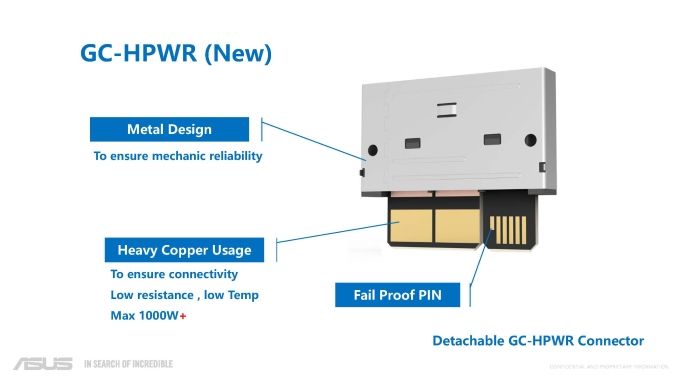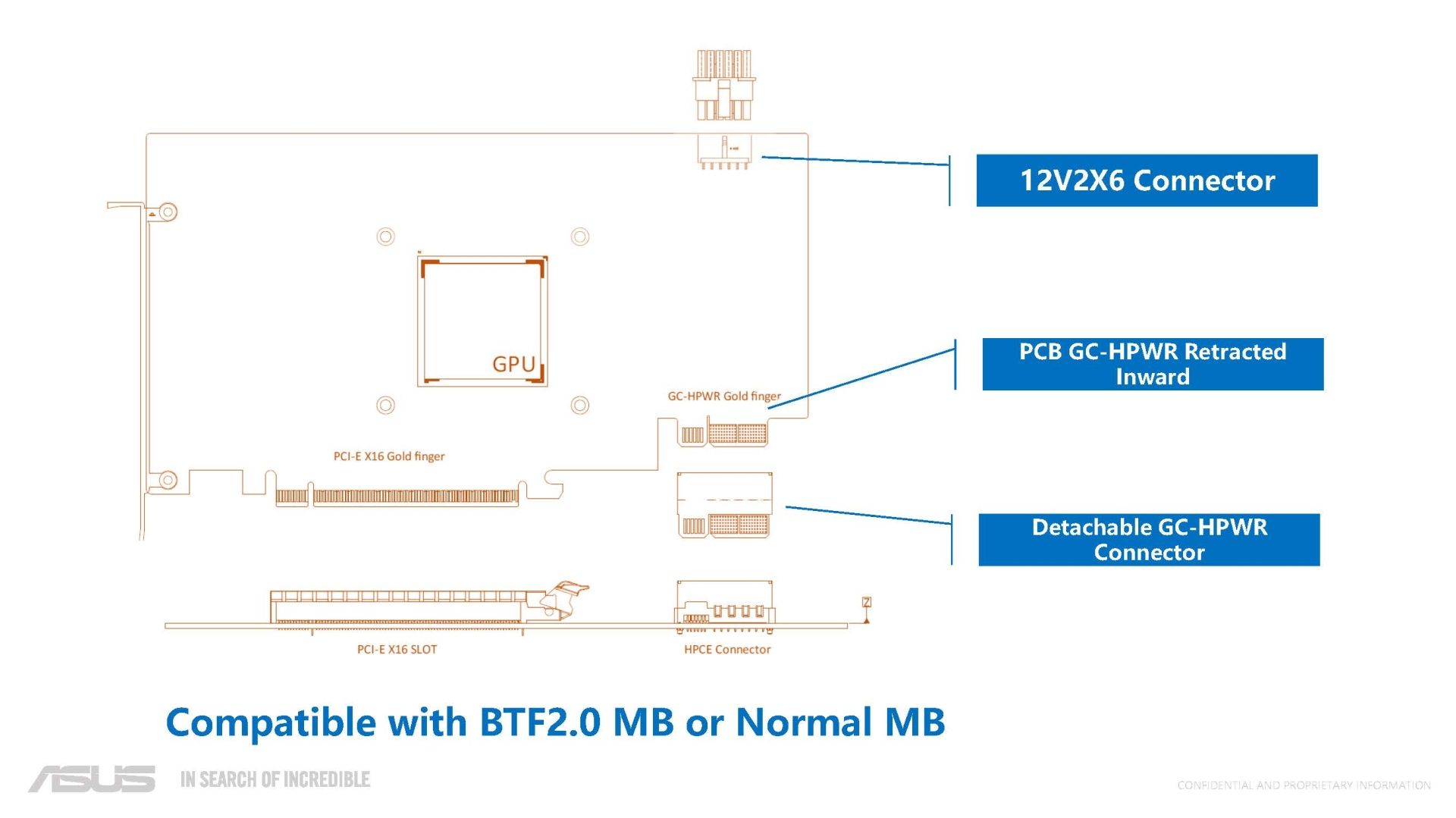Asus GPU power connector delivers 1,000W for cableless builds — GC-HPWR has a retractable design
BTF 2.0 branded GPUs will come with this new power connector

Asus has updated its BTF (Back to Future) standard with a new connector that provides significantly more power than the 12V-2x6 connector. HardwareLuxx reports that the new GC-HPWR connector is rated for 1,000W. It also features a retractable design, making the connector optional and improving BTF GPU compatibility with traditional motherboards.
BTF aims to improve PC aesthetics by reducing cable clutter. Products built around BTF feature connectors placed at the back of the motherboard, hiding the power cables. In other cases, BTF-branded Asus graphics cards use a proprietary connector next to the PCIe x16 slot to power the GPU instead of a supplementary power cable.
The GC-HPWR power connector is part of the company's new "BTF 2.0" refresh, focused on refining its homebrewed BTF standard. The revised power connector supports up to 1,000W of power. To achieve such high power draw capabilities, Asus has incorporated "heavy copper," which enables power to be drawn at a low resistance and temperature.


The BTF-style power connector is an optional deployment on BTF 2.0-branded graphics cards. BTF 2.0 graphics cards can run on BTF-supported and traditional motherboards without the proprietary power connector, a feat that was not achievable with first-generation BTF Asus GPUs.
To do this, BTF 2.0 graphics cards come with both Asus' proprietary GC-HPWR connector and a traditional 12V-2x6 power connector. Depending on the motherboard on which it is installed, the GPU can be used with either connector. The GC-HPWR connector appears to be retractable or removable, so you can withdraw it when using conventional power cables.
The GC-HPWR power connector has also been recessed inwards to make compatibility with mainstream motherboards possible. Users who want to pair a BTF 2.0 GPU with a BTF-compatible motherboard will need to use a GC-HPWR connector/adapter to connect the GPU to the motherboard to make up the distance.
Asus has yet to announce whether it release BTF 2.0 motherboards and graphics cards is unknown. Thus far, the brand has not announced any RTX 50-series or Radeon RX 9070-series products with the BTF 2.0 standard.
Get Tom's Hardware's best news and in-depth reviews, straight to your inbox.

Aaron Klotz is a contributing writer for Tom’s Hardware, covering news related to computer hardware such as CPUs, and graphics cards.
-
ekio It will only be adopted widely if it becomes part of JEDEC standards.Reply
If it's proprietary tech, that will go nowhere.
I think it's a great improvement over old school cables. -
jlake3 I suppose that does solve the issue with these cards being locked to this form factor on the second-hand market (at the cost of now having to look at an unpopulated connector), but this whole standard seems like a solution in search of a problem... a problem other than "I want my us$2.5k+ showcase build to look prettier".Reply
Sure, you can make really clean looking showcase builds, but your part selection ends up limited and seemingly restricted to only very premium parts, your case ends up wider due to adding connectors on the backside and not reducing any depth on the front side (and even wider if you replace a top or bottom mount, cabled PSU with a socketed one...), temperatures don't meaningfully improve because the area blocked by well-managed cables in a well-designed case is negligible, CPU cooling fans still need cables unless the idea is that this form factor will always be liquid-cooled...
Oh, and it seems to be constantly evolving, and burning early adoptees as it does. If you bought an early BTF case, you'll have to buy a new case for BTF 3.0 due to PSU changes. Bought a first-gen BTF GPU and wanna trade up? ATX intercompatability is an optional feature only introduced with BTF 2.0, so good luck finding a buyer! -
newtechldtech Reply
This is not for the average buyer. This is aimed at $4000+ gaming PCs full water cooled and it has a huge market among the rich people. And there are Tons of buyers dont worry.jlake3 said:I suppose that does solve the issue with these cards being locked to this form factor on the second-hand market (at the cost of now having to look at an unpopulated connector), but this whole standard seems like a solution in search of a problem... a problem other than "I want my us$2.5k+ showcase build to look prettier".
Sure, you can make really clean looking showcase builds, but your part selection ends up limited and seemingly restricted to only very premium parts, your case ends up wider due to adding connectors on the backside and not reducing any depth on the front side (and even wider if you replace a top or bottom mount, cabled PSU with a socketed one...), temperatures don't meaningfully improve because the area blocked by well-managed cables in a well-designed case is negligible, CPU cooling fans still need cables unless the idea is that this form factor will always be liquid-cooled...
Oh, and it seems to be constantly evolving, and burning early adoptees as it does. If you bought an early BTF case, you'll have to buy a new case for BTF 3.0 due to PSU changes. Bought a first-gen BTF GPU and wanna trade up? ATX intercompatability is an optional feature only introduced with BTF 2.0, so good luck finding a buyer! -
newtechldtech Reply
go no where ? people who pay $4000-$7000 for a gaming PC dont care about selling it later , they just give it to their driver as a gift, and build a new one.ekio said:It will only be adopted widely if it becomes part of JEDEC standards.
If it's proprietary tech, that will go nowhere.
I think it's a great improvement over old school cables. -
Misgar Oh goody! Let's run up to 1kW of power through the motherboard tracks. A big change from the nominal 75W allowed in the PCIe spec for a typical card socket.Reply
I can envisage another Cu layer to provide sufficient area for the current density and there's still the interface between the PSU and the motherboard to consider. Shades of 12VHPWR connector melting again if they get it wrong.
Should be reasonably well engineered in a $10K+ workstation or server, but in a gaming machine?